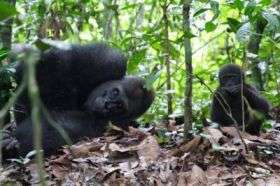Ice Ages and rivers may have affected gorilla diversification

Geography and historical climate change may have both played a major role in gorilla evolutionary diversification, according to a new genetic study by Cardiff University and the University of New Orleans.
The collaborative School of Biosciences study shows that the genetic composition of gorilla populations varies across different parts of their current geographic range and that this variation may be tied to Ice Age climate change and river barriers.
Professor Mike Bruford, School of Biosciences said: “This wide ranging variation is a crucial consideration given the current catastrophic decline of great apes throughout Central Africa, current climate change patterns and the need to develop strategies to protect remaining populations from extinction.”
Using DNA data extracted from shed hair and faeces, the researchers found that regional differences in gorillas may have been shaped by Ice Age forest “refugia” that harboured remnants of suitable habitat and rivers that pose barriers to gorilla movement in the western Congo basin.
At high latitudes, expanding ice sheets forced some species into ice-free ‘refugia’ from which they evolved differences from one another. In contrast, the colder, drier climates experienced in the tropics led to the contraction of continuous forest into isolated pockets.
Geographic-based computer analyses also indicates that the genetic differences between gorilla populations is explained, in part, by the distance gorillas need to travel around river barriers, since in common with other large primates, they cannot cross large rivers.
The study published in the Proceedings of the National Academy of Sciences was carried out in collaboration with the Centre International de Recherches Medicales de Franceville (CIRMF), Gabon, and the Wildlife Conservation Society.
Source: Cardiff University

















